In the mind’s ear
Amorales’ ‘Triangle Constellation’ heightens experience of Calderwood Courtyard
Alexander Calder would have admired the new installation that hangs above the Harvard Art Museums’ Calderwood Courtyard. Constructed of 16 chrome-plated steel triangles, 15 painted steel bars, and black climbing rope, “Triangle Constellation” attaches to the steel trusses that support architect Renzo Piano’s glass ceiling. The piece evokes the work of Calder (1898–1976), the renowned American sculptor considered by many the father of the mobile.
It’s no surprise. Carlos Amorales, the Mexican artist who created the Harvard sculpture on a commission, was part of a residency at Calder’s country house and studio in Saché, France, three years ago. There in the French countryside, he immersed himself in Calder’s world and work, particularly the organic-seeming structure of the mobiles. “They have these branch-like ways of coming together,” Amorales said recently, speaking by phone from his studio in Mexico City. “By looking at his work I got this image: I wanted to make a mobile with symbols.”
That image became Amorales’ 2012 piece “We’ll See How All Reverberates,” which was displayed at the Guggenheim Museum in New York and is the predecessor to the Harvard work. In the earlier installation, Amorales opted for 35 copper symbols instead of steel triangles to create his “public instrument,” one that anyone could play with the piece’s accompanying mallets — no specific musical training or lengthy lessons required.
A mobile comes home
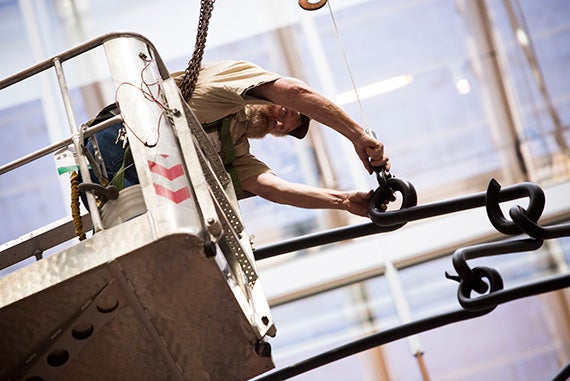
A new piece by Mexican artist Carlos Amorales is installed from the courtyard ceiling of the Harvard Art Museums. The installation is a large mobile made up of 16 large steel triangles. Jeff Cook is pictured during the installation. Photos by Stephanie Mitchell/Harvard Staff Photographer
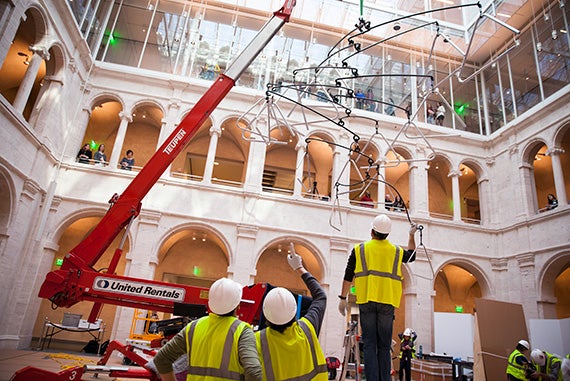
Museum staff work to hang the mobile. Carlos Amorales called the work “an expansion of the building.”
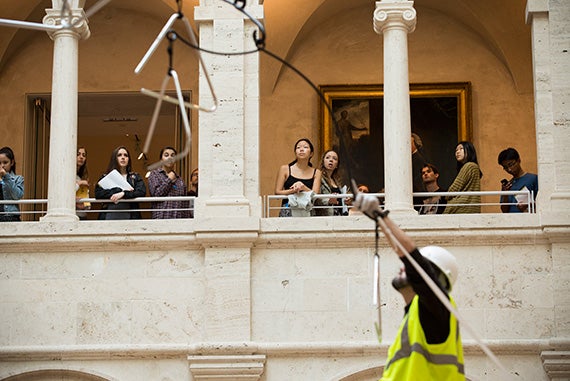
Museum guests observe the installation, which celebrates Piano’s architecture while encouraging visitors to “see the space differently,” said Mary Schneider Enriquez, the Houghton Associate Curator of Modern and Contemporary Art.
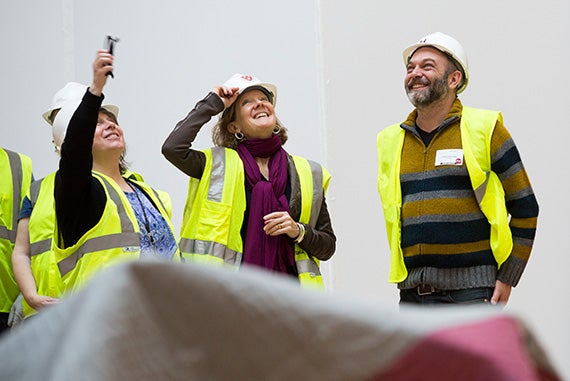
Harvard Art Museums’ Richard L. Menschel Curator of Photography Deborah Martin Kao (from left), Associate Curator of Modern and Contemporary Art Mary Schneider Enriquez, and artist Carlos Amorales watch the action.
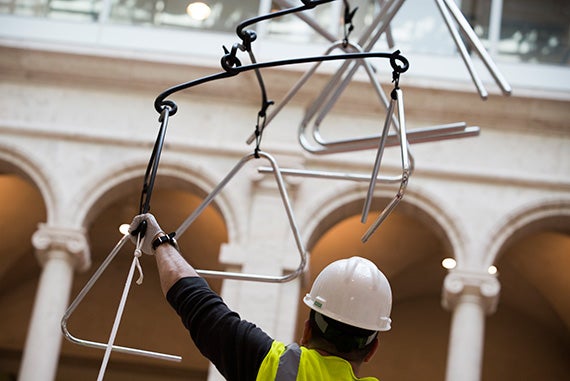
Collections Specialist Sean Lunsford lends a hand during the installation. According to Amorales, the Harvard piece is more “about the idea of sound than how it sounds.”
The same goes at the Harvard Art Museums. On special occasions, visitors will have the chance to treat Amorales’ piece as a giant instrument, swinging one of two long steel “strikers” to gently play the lowest hanging triangle, which is the size of a standard orchestral triangle. The triangles get bigger the higher up they hang. The largest measures almost 6 feet on each side.
But those musical interludes will be fleeting. According to Amorales, the Harvard piece is more “about the idea of sound than how it sounds.”
In planning the piece, Amorales and Harvard curators discussed its size and scope. It had to be big enough to animate the vast space, it had to complement Piano’s bold plan — which unites the Fogg, Busch-Reisinger, and Arthur M. Sackler museums under one roof — and it had to be transparent. (A key feature of Piano’s design is the open sightlines that allow visitors to easily peer into different collections from the museum’s central circulation corridor.)
Amorales called the work “an expansion of the building. You see how a triangle expands, how it becomes larger and larger. And then, how conceptually, you can see [through the triangles], but also through the windows, through the collections. It’s like a center.”
The sculpture also highlights curators’ ambition for public spaces in the newly reopened museums. Placing even more art in the courtyard fit “the opportunity to bring art out of a traditional gallery space and have it make a statement, so that visitors could then think of art in different ways,” said Mary Schneider Enriquez, the Houghton Associate Curator of Modern and Contemporary Art, who helped select Amorales for the commission.
His work, she said, also celebrates Piano’s architecture while encouraging visitors to “see the space differently.”
“We are up and alive,” added Enriquez, “but we are still actively moving forward and doing new things, and so this [work] puts a kind of frame around who we are as we grow.”




